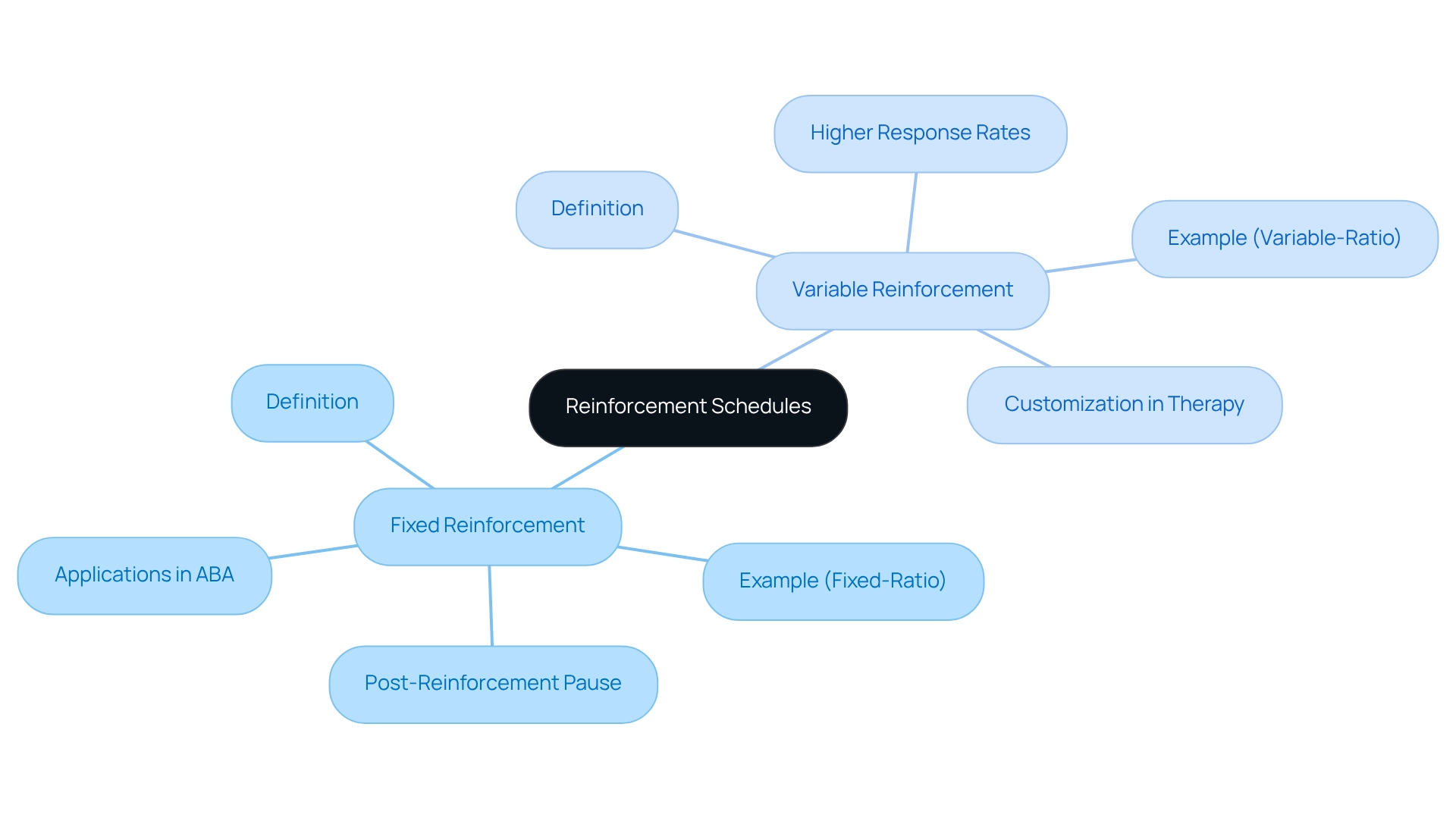May 30, 2025

A continuous reinforcement schedule, commonly referred to as CRF (Continuous Reinforcement), represents a pivotal method in ABA therapy. This approach reinforces a desired behavior every time it occurs, proving particularly effective during the initial learning stages. The consistent reinforcement fosters robust associations between actions and rewards, ultimately leading to significant progress in skill acquisition. Moreover, it is crucial to recognize the necessity of transitioning to variable reinforcement schedules for the maintenance of these behaviors in the long term.
In the realm of Applied Behavior Analysis (ABA), the art of reinforcement is paramount in shaping behaviors and facilitating learning. Continuous reinforcement, where desired actions are rewarded consistently, serves as a powerful tool during the initial stages of behavior acquisition. This approach fosters quick learning and establishes strong associations.
However, as practitioners navigate the complexities of behavior modification, transitioning to varied reinforcement schedules becomes essential for maintaining these behaviors over time. This article delves into the dynamics of reinforcement schedules, comparing the immediate effectiveness of continuous and fixed schedules with the long-term benefits of variable reinforcement.
Ultimately, it highlights their implications for successful ABA therapy. Through case studies and research insights, it reveals how these strategies not only enhance skill acquisition but also support sustained behavioral change, paving the way for improved outcomes in therapeutic settings.
In Applied Behavior Analysis (ABA), a continuous reinforcement schedule is also called a pivotal schedule, where a desired action is reinforced every time it occurs. This method proves especially effective during the early stages of learning, as it fosters a strong connection between the action and the reward. For instance, when a child learns to say 'please' before receiving a treat, consistent reinforcement accelerates the learning process. Notably, studies reveal that 66% of children who commence ABA therapy remain in treatment for 12 months, with 46% continuing for 24 months. This statistic underscores the therapy's positive impact on skill acquisition.
However, while ongoing support is advantageous for skill development, it poses challenges for long-term behavior maintenance. The risk lies in developing a reliance on immediate rewards. Practitioners must consider this dynamic, as transitioning to intermittent reward schedules can aid in sustaining behaviors over time. A continuous reinforcement schedule is also called CRF, and it is vital for shaping behaviors within ABA therapy settings, as illustrated by the case study titled 'Enhancing Communication Skills in Children with Autism Through ABA,' which exemplifies the effectiveness of ongoing support. It demonstrates that children receiving consistent reinforcement exhibit significant progress in communication and language skills, leading to improved social interactions. Experts emphasize that robust support systems can substantially elevate learning rates in children, establishing them as a fundamental component of . Furthermore, a study highlighted in an Abacus Therapies report indicates marked improvements in IQ and mainstreaming capabilities for those undergoing intensive ABA therapy compared to those receiving minimal treatment. As the field evolves, understanding the nuances of ongoing support remains essential for analysts and healthcare employers alike.
Fixed support plans deliver rewards following a predetermined number of responses or a specific time period. For instance, in a fixed-ratio arrangement, a child might receive a reward after every fifth occurrence of a desired behavior. This predictability can lead to a high rate of response but may also result in a post-reinforcement pause, where the subject temporarily stops responding after receiving the reward.
In contrast, provide rewards after an unpredictable number of responses or time periods. This unpredictability can lead to higher rates of response and greater resistance to extinction. For example, a variable-ratio system, similar to that utilized in gambling, keeps individuals involved because they never know when the next reward will arrive.
As Kendra Cherry observes, rewards are frequently given on a less predictable partial reward system, which can boost participation. Both timelines have their role in ABA therapy, with fixed plans being more straightforward for initial learning and variable arrangements being more effective for sustaining actions over time.
Recent studies suggest that the selection of reward timing should correspond with the actions being instructed and the intended reaction. A study titled 'Effect of Training Timetables on Progressive Ratio Performance' found that while both fixed and variable plans can be effective, the context and specific goals of therapy should guide their application, emphasizing the importance of customizing approaches to individual needs.

The timing of rewards in ABA therapy significantly impacts the effectiveness of conduct modification techniques. Continuous support is optimal for teaching new skills, as it promotes rapid learning and strong associations. However, as behaviors become established, transitioning to can enhance retention and reduce the likelihood of extinction.
For example, once a child learns to appropriately request a snack, moving to a variable-ratio plan can maintain that behavior over time without the necessity for constant reinforcement. Understanding the context in which each schedule is applied is essential; for instance, fixed schedules may be more suitable in structured environments like classrooms, while variable schedules can be more effective in naturalistic settings.
Ultimately, the strategic implementation of these schedules empowers BCBAs to optimize therapeutic outcomes and facilitate long-term behavior change.
The exploration of reinforcement schedules within the framework of Applied Behavior Analysis (ABA) highlights their critical role in shaping behavior and fostering learning. Continuous reinforcement acts as a powerful mechanism during the initial stages of behavior acquisition, enabling rapid skill development and strong associations between desired actions and rewards. However, transitioning to fixed and variable reinforcement schedules is equally essential for maintaining these behaviors over time, as reliance on immediate rewards can hinder long-term success.
A comparison between fixed and variable reinforcement schedules reveals important insights into their applications in ABA therapy. While fixed schedules provide predictability that can enhance early learning, variable schedules introduce unpredictability that fosters sustained engagement and resilience against extinction. The choice of reinforcement strategy must align with the specific behavior being taught and the therapeutic goals, emphasizing the need for tailored approaches to individual needs.
Ultimately, the effective use of reinforcement schedules not only optimizes the learning process but also supports lasting behavioral change. By understanding and strategically implementing these schedules, practitioners can enhance therapeutic outcomes and facilitate meaningful progress in their clients. As the field of ABA continues to evolve, mastering reinforcement dynamics will remain a cornerstone for achieving success in behavior modification and therapy.
What is a continuous reinforcement schedule in Applied Behavior Analysis (ABA)?
A continuous reinforcement schedule, also known as a pivotal schedule, is a method where a desired action is reinforced every time it occurs. This approach is particularly effective during the early stages of learning as it strengthens the connection between the action and the reward.
How does continuous reinforcement impact learning in children?
Continuous reinforcement accelerates the learning process. For example, when a child learns to say 'please' before receiving a treat, consistent reinforcement helps them quickly associate the action with the reward.
What percentage of children remain in ABA therapy for 12 to 24 months?
Studies indicate that 66% of children who start ABA therapy remain in treatment for 12 months, and 46% continue for 24 months. This suggests a positive impact of the therapy on skill acquisition.
What are the challenges associated with continuous reinforcement?
While ongoing support through continuous reinforcement is beneficial for skill development, it can lead to challenges in maintaining behaviors over the long term. One risk is that individuals may become reliant on immediate rewards.
How can transitioning to intermittent reward schedules help?
Transitioning to intermittent reward schedules can aid in sustaining behaviors over time, reducing reliance on immediate rewards.
What does the case study 'Enhancing Communication Skills in Children with Autism Through ABA' demonstrate?
This case study illustrates that children receiving consistent reinforcement show significant progress in communication and language skills, which leads to improved social interactions.
What are the benefits of robust support systems in ABA therapy?
Experts emphasize that robust support systems can significantly elevate learning rates in children, making them a fundamental component of effective ABA therapy.
What improvements have been noted in children undergoing intensive ABA therapy?
A study highlighted in an Abacus Therapies report indicates that children undergoing intensive ABA therapy show marked improvements in IQ and mainstreaming capabilities compared to those receiving minimal treatment.
Our expert recruitment strategies and AI-driven sourcing ensure that you receive top-notch candidates quickly, without compromising on quality. Whether you’re looking for BCBAs, Clinical Directors, or RBTs, we’ve got you covered.